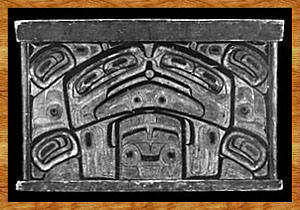
 North Coast North Coast
 Art Style Art Style
 Flat Design Flat Design
 Sculpture Sculpture |
Flat Design
Elaborate two-dimensional designs called "flat designs" are characteristic of Northwest Coast art and are tightly controlled by formal canons of both line and form. The Haida made far fewer large-scale paintings, such as housefronts and screens, than their Tsimshian neighbours. The Haida were, however, the masters of subtly sculpted flat design -- a kind of bas-relief -- in which the secondary and tertiary spaces were enhanced with gently swelling or concave planes between the primary formlines. In the past, the Haida used less complex textured zones of cross-hatching or parallel lines around eye forms than did Tsimshian and Heiltsuk artists. Although early Haida artists are not known by name, art historian Bill Holm, after a close study of disparate works such as totem poles, housefront paintings, chief's seats and argillite carvings, identified one early master painter and sculptor as "the Master of the Chicago Settee," after the first piece of his work to attract the appreciation of experts like Holm, Wilson Duff and Haida artist Bill Reid.
From the 1870s on, numerous Haida artists who are known by name became remarkably free and innovative in their paintings, depicting animal, fish and bird forms with a greater degree of realism than before, and often in quite a narrative dimension. This creative development is undoubtedly related to the fact that these artists, of which there were several dozen, were working in both argillite and paint, using formline designs on a variety of objects intended to appeal to foreign visitors.

The best known of these artists were Charles Edenshaw, Tom Price, John Robson and John Cross, but there were many others. A small number of Skidegate artists also applied radical painting styles to box or drum designs with intriguing results. It is virtually impossible to differentiate the nineteenth-century boxes decorated in the various villages of the north coast groups, as these served as containers of trade items among those communities. However, tribal styles are distinctive in boxes and chests owned by chiefs for storing wealth items and for burial chests (or coffins).
John Cross, John Robson, Tom Price and Charles Edenshaw also produced many flat designs that fit into the category of "ledger drawings," a form common to Indian art of the late nineteenth century. These were often elaborate drawings based on tattoo designs, done from memory in ledgers or copybooks provided by the administrators and missionaries who entered Indian communities to educate and Christianize them. Drawing skills were considered important and were encouraged by supplying coloured pencils, crayons and paper. The Haida needed little encouragement in adopting these new materials to provide samplers of totemic and other designs that were much in demand by collectors.
Haida flat design has survived and is in fact thriving in the limited edition print market that sprang up in the late 1960s. Many artists like Don Yeomans, Gerry Marks and Reg Davidson have produced hundreds of images that are sold in fine art galleries throughout the world. The current master of this form of painting and printmaking is Robert Davidson (a descendant of Charles Edenshaw).
|